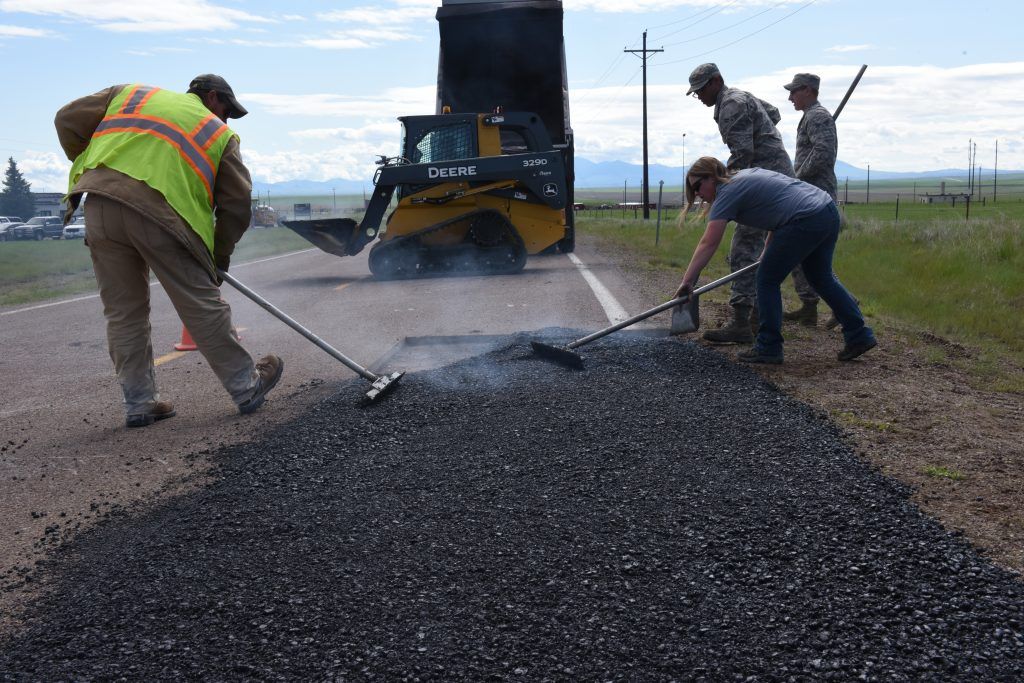Hot Mix Asphalt Paving: Redefining Commercial Residential Property Landscapes
Wiki Article
Opening the Keys of Warm Mix Asphalt Technology
Discovering the midsts of hot mix asphalt innovation reveals a world where accurate solutions and careful procedures merge to form our roadways and facilities. The fusion of fillers, binders, and accumulations isn't just a construction job yet a strategic orchestration of durability and efficiency. As we peer into the complex dance of components, a tapestry of durability and sustainability unravels. What exists under this surface of asphaltic proficiency, and what secrets wait to be unveiled in the realm of paving innovations?Value of Warm Mix Asphalt
Warm Mix Asphalt plays an essential function in modern-day framework growth due to its resilience and cost-effectiveness. As one of the most generally utilized paving material for roads, freeways, and car park, Hot Mix Asphalt offers a variety of benefits that contribute to its importance in building and construction tasks. One crucial advantage is its capability to endure hefty website traffic tons and extreme weather, giving a trustworthy and resilient surface area for transport networks. Furthermore, Warm Mix Asphalt is cost-efficient in both first building and construction and lasting upkeep, making it a favored selection for several facilities projects.The resilience of Hot Mix Asphalt stems from its structure, which consists of accumulations, binder, and filler products that are very carefully selected and mixed to meet particular efficiency needs. Generally, the importance of Warm Mix Asphalt in framework advancement can not be downplayed, as it proceeds to be a foundation of modern-day building techniques.
Components of Asphalt Mixes
The composition of asphalt blends contains very carefully selected aggregates, binder, and filler products that are important for attaining details performance demands. Aggregates are the primary element of asphalt blends, giving toughness and security. These accumulations can be all-natural, such as crushed rock or crushed rock, or synthetic, like recycled products from old pavements. The binder, typically bitumen or asphalt cement, holds the aggregates together and supplies flexibility and toughness to the mix. The choice of the binder is vital as it directly influences the mix's efficiency in various climate condition. Fillers, such as moisturized lime or Rose city cement, are made use of to improve the mix's workability and aging resistance. Angled Parking.The mix and proportion of these parts play a substantial function in identifying the high quality and efficiency of the asphalt mix. Designers thoroughly create the mix to satisfy certain needs, considering elements like website traffic volume, climate conditions, and pavement lifespan. Correct option and harmonizing of accumulations, binder, and fillers are essential for developing resilient, lasting asphalt sidewalks.
Combining and Production Strategies

As soon as the accumulations are picked, the binder, usually asphalt cement, is contributed to bind the products together. The binder's quality and quantity substantially affect the mix's resistance, versatility, and strength to environmental aspects. Additionally, fillers like hydrated lime or Portland concrete might be included to enhance details attributes of the asphalt mix, such as its workability or moisture resistance.
Throughout production, the aggregates and binder are heated up, generally in between 250-325 ° F(121-163 ° C ), to assist in mixing and make certain appropriate finishing of the accumulations. The mixing process needs to be thorough to attain a homogeneous blend that advertises the preferred performance attributes of the asphalt. Various methods, such as batch blending or drum mixing, are utilized to achieve top notch and regular asphalt blends for construction projects.
Aspects Affecting Asphalt Efficiency
Variables affecting asphalt performance encompass a series of variables that affect the sturdiness, long life, and general quality of asphalt pavements. One vital element is the quality of materials made use of in the asphalt mix. The type and source of accumulations, the binder high quality, and the ingredients all play a significant duty in figuring out the performance of the asphalt sidewalk. The rank of aggregates is important as it influences the mix's workability, resistance, and security to rutting and cracking.
Layout considerations, such as pavement density and drain, are important in making certain the long-lasting performance of the asphalt sidewalk. By carefully considering these engineers, professionals and variables can maximize asphalt performance and improve the service life of sidewalks.
Sustainable Practices in Asphalt Innovation

WMA permits for the manufacturing and placement of asphalt mixes at reduced temperature levels contrasted to typical hot-mix asphalt, resulting in decreased power hot mix asphalt consumption and greenhouse gas discharges. The usage of permeable asphalt blends can aid mitigate stormwater runoff problems by allowing water to infiltrate through the sidewalk and into the ground, advertising all-natural water purification and recharge procedures.
Verdict
In final thought, warm mix asphalt innovation plays a crucial function in modern-day facilities development due to its sturdiness and cost-effectiveness. By very carefully stabilizing elements, utilizing appropriate mixing strategies, and taking into consideration different factors, designers can develop high-quality asphalt mixes that endure rush hour loads and extreme weather. Embracing sustainable methods, such as utilizing recycled materials and warm-mix modern technologies, additionally enhances the environmental kindness of asphalt modern technology.
Blending and production methods in hot mix asphalt innovation involve the specific combination and handling of aggregates, binder, and fillers to develop a sturdy and high-performance asphalt mix.Elements affecting asphalt performance include a variety of variables that affect the durability, durability, and general top quality of asphalt sidewalks. Lasting methods in asphalt innovation encompass numerous efforts aimed at reducing the ecological influence of asphalt manufacturing and paving procedures. By including recovered asphalt sidewalk (RAP) and recycled asphalt roof shingles (RAS) right into brand-new asphalt mixes, the sector can dramatically lower the intake of raw products and power, while also lowering land fill waste.
WMA allows for the manufacturing and positioning of asphalt blends at reduced temperatures compared to conventional hot-mix asphalt, resulting in decreased energy consumption and greenhouse gas discharges.
Report this wiki page